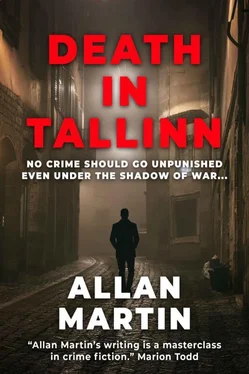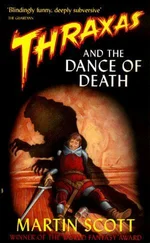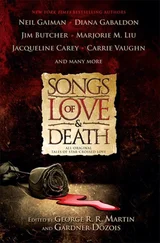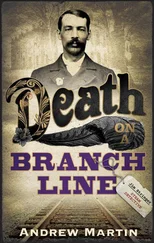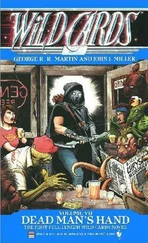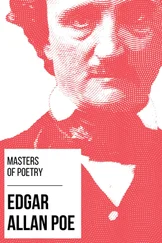“Democracy in action, eh?” The colonel smiled. “Of course, we can’t demand a response immediately. Today’s Thursday, so why not let me know sometime on Monday morning? Does that sound reasonable?”
“Yes, it does. Thank you, Colonel. That’s quite a lot to think about. I’ll call you on Monday.”
“Tell you what. I’ll even throw in the car, and Lembit as well, if you take the job.”
Back in his office, he called the University Library in Tartu. The library was housed in the restored western end of the ruin of the great cathedral that once dominated the entire city from its position on the hill above it, and he could imagine someone making their way to the tiny basement room where Kirsti worked, cataloguing the library’s English language collections.
“ Tere , Jüri! Is something wrong? You don’t usually have me dragged up from the crypt. Don’t tell me you’ve to stay up there for another week after all.”
“No, no. Quite the opposite. It’s all done, and I’m coming home tomorrow.”
“Fantastic. I’m off work at four, so if you’re getting the one o’clock train from Tallinn, I can meet you at the station.”
“Yes, that would be nice. There’s something else, too. A job offer…”
Since our first visit to Estonia, we’ve grown to love the country, and I even made an effort to learn the language. So what better place to set a crime story. My wife Vivien is my First Reader and honest critic, and that makes a big difference. Thanks also to others who have read part or all of the book, especially Liz Pugh, to Maarika Teral for valuable comments from Estonia, and to Richard Foreman for deciding that this book was worth publishing.
I’ve tried to set the story in an accurate historical background. The only real historical figures who appear (very briefly) in the book are Ado Anderkop, Konstantin Päts, Viktor Rotenbork, and Jaan Tönnisson. All other characters taking part in the action are fictitious. I have recreated 1930s Tallinn as accurately as possible, and apologise for any errors therein.
A Brief Overview of Estonian History
Although the Estonians have been settled at the eastern end of the Baltic Sea since at least the beginning of our era, Estonia only became an independent state in 1918. Up to the late twelfth century the tribes lived more-or-less undisturbed. But at the beginning of the thirteenth century foreign domination arrived, in the shape of the Knights of the Sword, a crusading order recruited mainly in Germany. Under the guise of bringing Christianity to pagans, the knights subjugated the tribes and seized their lands. The Germanic landowning class, known as Baltic Germans, remained in place for the next 700 years.
After a serious defeat in 1236, the Knights of the Sword were incorporated into the larger and more powerful Teutonic Order. The Estonian lands were divided into a patchwork of territories, owing allegiance to the Order, the Bishop of Ösel (on the island of Saaremaa) or the Bishop of Dorpat (Tartu), and this situation persisted up to the Reformation, when the area became Lutheran, and the Teutonic Order transformed itself into the Duchy of Prussia.
A major upheaval came in the late 1500s, when Ivan the Terrible, Tsar of Russia, attempted to incorporate the eastern Baltic shores into his empire. A bloody war followed, as other powers in the area invaded the Estonian lands to resist the Russian advance westwards. Ultimately the Swedes emerged supreme in the early 1600s, and their rule in Estonia was regarded as “the good old Swedish time.” Although the Baltic Germans, now swearing allegiance to the King of Sweden, retained their lands, their powers were constrained by the Swedish authorities, and peasants gained rights they were not to regain until the 19 thcentury.
By the early 18 thcentury Swedish power was waning, and the Russia of Peter the Great on the move, and in the Great Northern War (1700-1720) Russian armies gained control of Estonia (as well as Latvia and Lithuania), and the Baltic states were incorporated into the Russian Empire. The Baltic German landowners once again retained their lands and now swore fealty to the Russian Tsar. They weren’t unhappy about this, as the protection of peasants’ rights given by the Swedes was swept away, and they could treat the indigenous people as their slaves once again.
The city of Tallinn had been founded by the Danes, during a short-lived involvement in Estonia’s history in the twelfth century, hence the name (from Taana Linn = “Danish town”). They built a castle on the hilltop site of a native fort, and the town grew at the foot of the hill. A cathedral was built on the hill, hence its name Toompea (= “cathedral hill”), and here the governor’s office was located, and the aristocracy built their townhouses.
With a good harbour, Tallinn became a major port, and during the Middle Ages was a member of the Hanseatic League. Most of the merchants who established themselves there were, like the landowners, of German extraction, and the German merchants ran the town council until well into the nineteenth century. Tallinn’s trade was boosted by the incorporation of Estonia into the Russian Empire, as the port was ice-free in winter, yet not too far from the capital St. Petersburg, and much traffic now passed through its harbour.
During the nineteenth century an indigenous Estonian middle class emerged, and with it came a movement for cultural emancipation, focused on the use of the Estonian language, which had suvived as the language of the peasantry. This cultural movement was met with suspicion from both the Russian rulers and the German landowners. Nevertheless books were published in Estonian, dramas were performed, and a tradition of local choirs was founded, which fed into a national Song Festival held every four or five years.
Industry also grew, and the western links of German entrepreneurs enabled some large factories to develop, producing such materials as textiles and plywood for the huge Russian market. Tallinn grew as people moved from the land into the city in search of work. The port of Tallinn also continued to prosper as the winter gateway to Russia, goods being moved directly from ship to railway wagon for shipment eastward.
The First World War and its aftermath changed everything. Russian and German armies moved through the Baltic provinces. But Russia’s archaic structure could not support modern warfare, and the result was mutiny and revolution in 1917. As Russia imploded into civil war, and the soldiers came home, the Baltic states saw an unexpected opportunity to free themselves. Estonia declared its independence on 24th February 1918, a few days before invading German armies arrived. But later that year Germany surrendered to its Western opponents. This marked the start of the two-year Independence War, as Estonian armies fought against the Red army on one front, trying to bring Estonia into the new Soviet Union, and a freelance German army seeking to make the Baltic states into a German duchy, supported by most of the Baltic German landowners. Finally the Estonians emerged victorious, beating off a number of Red army thrusts, and defeating the German mercenaries at Võnnu in Latvia, making possible both Latvian and Estonian independence.
The new state had much to do to build its social, economic and political infrastructure. The first task was land reform, and a radical measure confiscated most of the Baltic German-owned lands and redistributed them to Estonian farmers. Estonia was transformed from a nation of landless peasants to one of small farmers. Many of the Baltic Germans left for Germany. Those who remained were left enough land for a single farm, on which they were obliged to be resident. With the loss of the huge Russian market, industry too had to readjust itself to the comparatively tiny domestic market. But Estonians are a hard-working people, and new export markets were found, as Estonian agricultural produce, butter and bacon in particular, found ready customers in Britain and Germany. Estonians had to learn how to do politics too. The new constitution was thoroughly democratic, leading to constant coalitions, with the same politicians shuffling power between them.
Читать дальше
